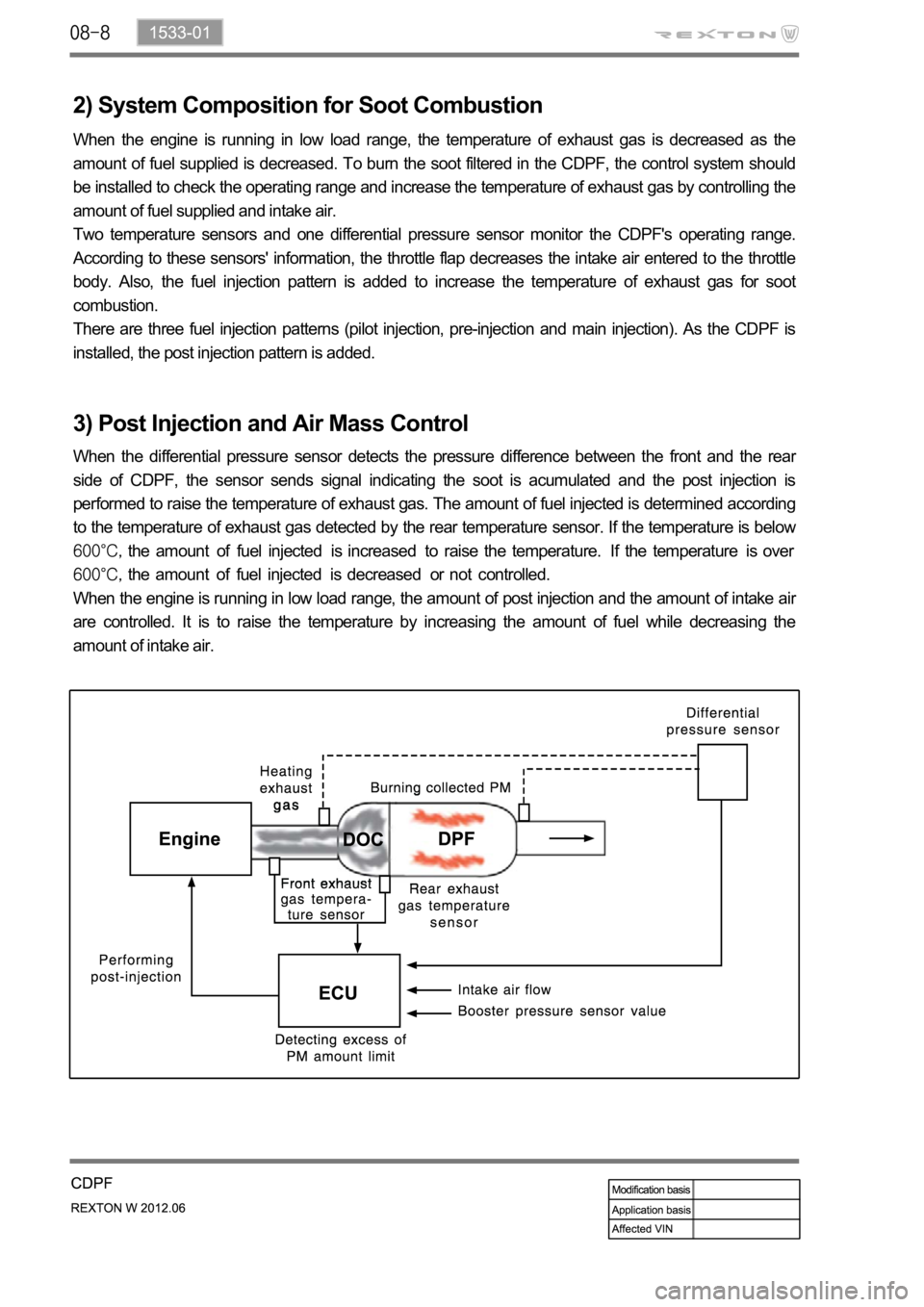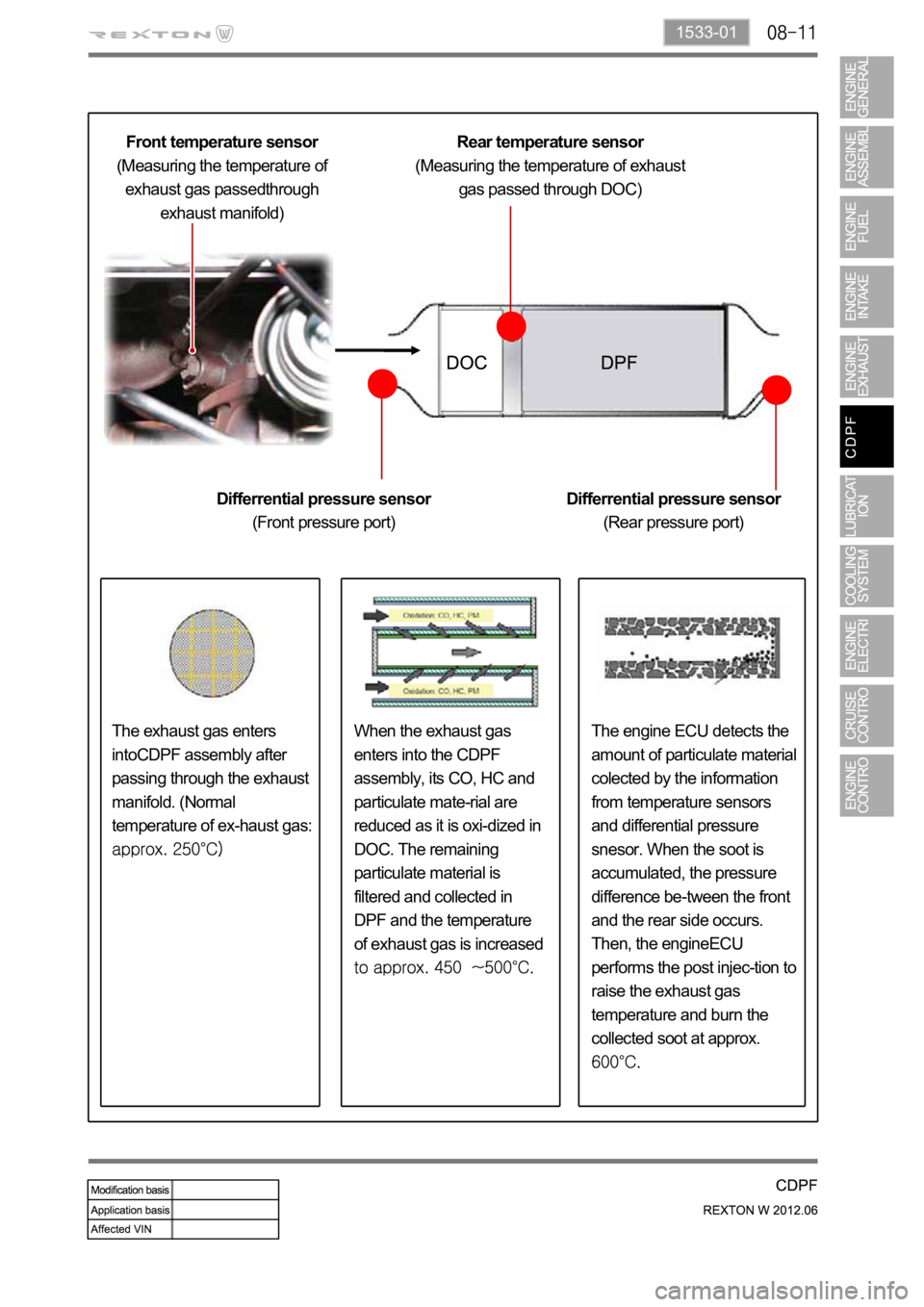Page 221 of 600

1533-01
1. OVERVIEW FOR CDPF (EURO IV)
The CDPF (Catalyst & Diesel Particulate Filter) was installed to the Rexton II D27DTP engine previously.
However, it is now installed to the all 2009 DI engine models, except the Actyon Sports. The DI engine
type sinstalled to Rexton are D27DTP, D27DT and D20DT, and their CDPF, related sensor and
operation logic are the same.This section describes the CDPF system (based on Euro IV) which is
installed to the Rexton II D27DTPengine (older model).
1) General Description
2) Compatibility of CDPF System by Vehicle Model
Rexton II: Same CDPF system for D27DTP and D27DT engines (including its components)
Kyron & Actyon: Same CDPF system for D27DT and D20DT engines (including its components)
The CDPF assemblies installed to the Euro IV D27DTP Rexton II and 2009 Rexton II are
different in their mounting layout, but their front/rear exhaust temperature sensors and
differential pressure sensors are same. -
3) System Met with EURO IV Regulations
The Ssangyong vehicles installed with the D27DT engine manufactured from July 2007 to December
2007 comply with the EURO IV regulations. Modified components from the old engine model are as
follow:
- E-EGR valve
- EGR cooler
- Engine ECU (Ver. 3.2)
- HFM senso
- C3I injector
- Electronic throttle valve (body)
- Other engine mounting components
For details about the modified components and system related to the EURO IV regulations, refer to the
2008 Rodius engine service manual.
Page 226 of 600

2) System Composition for Soot Combustion
When the engine is running in low load range, the temperature of exhaust gas is decreased as the
amount of fuel supplied is decreased. To burn the soot filtered in the CDPF, the control system should
be installed to check the operating range and increase the temperature of exhaust gas by controlling the
amount of fuel supplied and intake air.
Two temperature sensors and one differential pressure sensor monitor the CDPF's operating range.
According to these sensors' information, the throttle flap decreases the intake air entered to the throttle
body. Also, the fuel injection pattern is added to increase the temperature of exhaust gas for soot
combustion.
There are three fuel injection patterns (pilot injection, pre-injection and main injection). As the CDPF is
installed, the post injection pattern is added.
3) Post Injection and Air Mass Control
When the differential pressure sensor detects the pressure difference between the front and the rear
side of CDPF, the sensor sends signal indicating the soot is acumulated and the post injection is
performed to raise the temperature of exhaust gas. The amount of fuel injected is determined according
to the temperature of exhaust gas detected by the rear temperature sensor. If the temperature is below
the amount of fuel injected is increased to raise the temperature. If the temperature is over
the amount of fuel injected is decreased or not controlled.
When the engine is running in low load range, the amount of post injection and the amount of intake ai
r
are controlled. It is to raise the temperature by increasing the amount of fuel while decreasing the
amount of intake air.
Page 229 of 600

1533-01
Front temperature sensor
(Measuring the temperature of
exhaust gas passedthrough
exhaust manifold)Rear temperature sensor
(Measuring the temperature of exhaust
gas passed through DOC)
Differrential pressure sensor
(Front pressure port)Differrential pressure sensor
(Rear pressure port)
The engine ECU detects the
amount of particulate material
colected by the information
from temperature sensors
and differential pressure
snesor. When the soot is
accumulated, the pressure
difference be-tween the front
and the rear side occurs.
Then, the engineECU
performs the post injec-tion to
raise the exhaust gas
temperature and burn the
collected soot at approx. The exhaust gas enters
intoCDPF assembly after
passing through the exhaust
manifold. (Normal
temperature of ex-haust gas: When the exhaust gas
enters into the CDPF
assembly, its CO, HC and
particulate mate-rial are
reduced as it is oxi-dized in
DOC. The remaining
particulate material is
filtered and collected in
DPF and the temperature
of exhaust gas is increased
Page 231 of 600

1533-01
Overload of CDPF (warning lamp blinking)
Excessive overload of CDPF (warning lamp illuminated)
If the CDPF cannot reach the regeneration tem-
perature due to low speed driving or other reason during
the regeneration process, the soot is con-tinuously
accumulated in the CDPF. When this condition continues
and the CDPF is overloaded with soot, the engine
warning lamp blinks to in-form this situation to the driver.
In order to solve this problem, drive the vehicle at a speed
of approx. 80 km/h for 15 to 20 minutes to perform the
CDPF regeneration process.
If the engine warning lamp on the instrument clus-te
r
blinks, the CDPF is overloaded. In this case, perform the
step 2. 1.
2.
3.
If the vehicle is driven at a speed of 5 to 10 km/h for an
extended period of time, the soot accumu-lated in the
CDPF cannot be burnt as the CDPF cannot reach the
regeneration temperature. Then, an excessive amount o
f
soot can be accumulated in the CDPF.
This case is much worse than the simple over-load of the
CDPF. To inform this to the driver, the engine warning
lamp comes on and the engine power is decreased to
protect the system.
To solve this problem, blow soot between the en-gine and
exhaust system several times and erase the related DTC.
Then, check if the same DTC is regenerated again. If so,
check the DTC related to the differential pressure sensor. 1.
2.
3.
Actually, the DTC for the CDPF is generated more often by the component related to the CDPF system,
such as the differential pressure sensor, than by excessive soot in the CDPF. Blinking
Illumination
Page 232 of 600
Throttle Body
Engine compartment
(RH)
4. COMPONENTS OF CDPF SYSTEM
1) Mounting Condition and Location
Differential Pressure Sensor
Rear exhaust gas
temperature sensor
Front Exhaust Gas
Temperature Sensor
Front exhaust gas
temperature sensor
Rear pressure
port
CDPF assemblyFront pressure portDifferential
pressure
sensor
Page 274 of 600
0000-00
3. CHECK AND INSPECTION
1) Cylinder
(1) Compression pressure test
Specified value
Compression ratio16.5 : 1
Test condition
Compression pressureStandard32 bar
Minimum18 bar
Differential limit between cylindersMaximum 3 bar
The compression pressure test is to check the conditions of internal components (piston, piston ring,
intake and exhaust vale, cylinder head gasket). This test provides current engine operating status.
Before cranking the engine, make sure that the test wiring, tools and persons are keeping away
from moving components of engine (e.g., belt and cooling fan).
Park the vehicle on the level ground and apply the parking brake.
Do not allow anybody to be in front of the vehicle. -
-
-
Measurement
Disconnect the fuel rail pressure sensor connector to cut off the fuel injection.
Remove the air cleaner duct and glow plugs. -
-
-
Place the diagram sheet to compression
pressure tester and install it into the plug hole. 1.
Page 428 of 600
Excessive overload of CDPF (warning lamp illuminated)
If the vehicle is driven at a speed of 5 to 10 km/h for an extended period of time, the soot
accumulated in the CDPF cannot be burned as the CDPF cannot reach the regeneration
temperature. Then, an excessive amount of soot can be accumulated in the CDPF.
This case is much worse than the simple over-load of the CDPF. To inform this to the driver, the
engine warning lamp comes on and the engine power is decreased to protect the system.
To solve this problem, blow soot between the engine and exhaust system several times and erase
the related DTC. Then, check if the same DTC is regenerated again. If so, check the DTC related to
the differential pressure sensor. 1.
2.
3.
Illuminating
Page 430 of 600
Differential pressure
sensor
Calculates the amount of
PM collected by reading the
pressure difference between
before and after the CDPF.Engine ECU
DCM 3.7
Post-injectionThrottle
valve
Regulates the rate of air
intake.
CDPF
DOC+DPFFront temperature
sensor
Protects the turbocharger.Rear temperature sensor
Measures the temperature
of fuel combustion.
2. COMPONENT
For details, refer to section "Engine Control". *